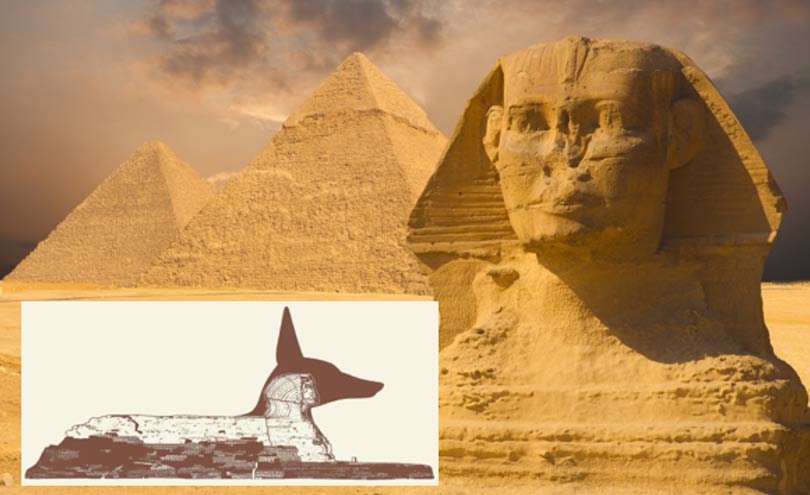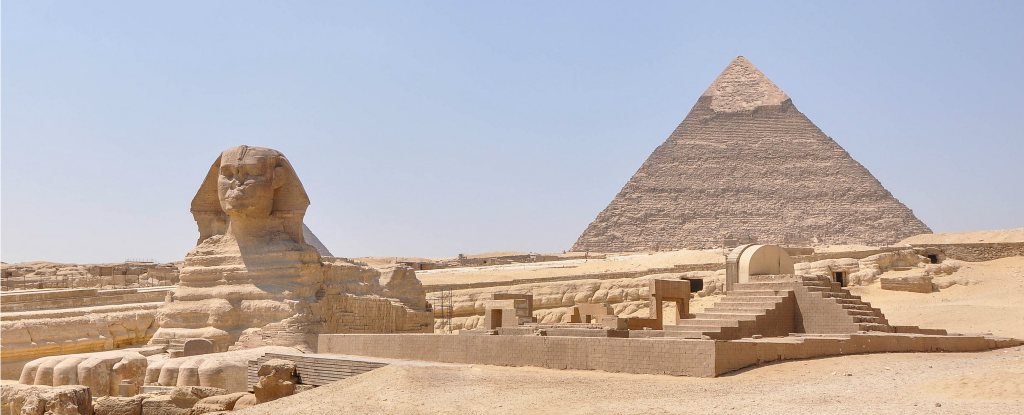السلام عليكم! (as-salāmu 3aleikum)
In Arabic, the greeting above is literally translated to mean “May peace upon you.”
The writing in the title translates to “pyramid,” which is pronounced “hram.”
Now that we have dealt with the pleasantries, let us dive into this weeks topic. We are taking a step back in time to learn about some of the world’s most beautiful creations: the pyramids and other historical statues of ancient Egypt! For some, the infamous landmarks of Egypt need no introduction. However, for the sake of this post, I am going to do just that!
I am going to explore some of the most importance features of these landmarks, and hopefully provide context for their creation and symbolism.
First, the Sphinx.

The largest surviving sculpture measures 73.5 m in length and 20 m in height. There is much to be wondered about the Sphinx considering no one is sure of who exactly constructed the landmark, or who it was designed to resemble. The dating, too, is questionable. The proportions of the Sphinx are peculiar. Observe any picture; it is very prominently shown that the hands, paying much more of a resemblance to paws, are abnormally long when you compare to the size of the head. This is because some believe that the Sphinx has not always been portrayed as a human. In fact, some attribute the dis-proportionality the fact that the initial structure could have possibly been constructed to reflect a pharaoh. This idea is illustrated in the image below.

Experts have inspected the Sphinx and found patterns of water and sand erosion, leading them to believe the landmark dates somewhere between 7,000 and 10,000 years old. This theory, however, was dismissed because even though Egypt used to have major rain storms, they would have stopped before the creation of the Sphinx. Others believe its dates back even further. Another theory explains that the three pyramids and the Sphinx line up in a way that reflects the constellation, Orion’s belt.

Next, The Great Pyramids.

The pyramids were build in the beginning of the Old Kingdom to the close of the Ptolemaic era. It is important to understand why the pyramids were built, so let me provide some background. During the period of the Old Kingdom, Kings ruled over Egypt. Egyptian Kings are not like the traditional kings you may think of, instead, they balanced somewhere between being human and divine creatures. This is because the people believed they were chosen by the gods to act as a mediator, so there was great respect and appreciation for the rulers during and after their life. When Kings passed, the body was mummified for preservation because it was believed that part of the spirit remained with the body. If any of you are familiar with mummification, you will know that they body was buried in a tomb surrounded with gold, jewels, and other riches that were believed to carry over to the after life.
Fun Fact!: “The pyramid’s smooth, angled sides symbolized the rays of the sun and were designed to help the king’s soul ascend to heaven and join the gods, particularly the sun god Ra.”
Perhaps the most well-known pyramid is the Great Pyramid of Giza. At this point, you may be curious as to who the pyramid was designed for, and how old it actually is. Well, Ancient History Encyclopedia explains, “The Great Pyramid of Giza was built for the Fourth Dynasty Pharaoh Khufu (or Cheops), and was completed around 2560 BCE.” It is the largest of three pyramids. It’s smaller companions were built for Khufu’s wives. It is one of the oldest monuments on the list of the Seven Wonders of the World. The construction leaves much to be admired. The proportions are considered nearly perfect, and the monstrous size is undoubtedly curious. How large is the largest pyramid? Ancient History Encyclopedia cites, “It was 481 feet high (it has since lost its top and is currently 25 feet less tall) and covers 13.1 acres. It is estimated that 2.3 million stone blocks were used, weighing between 2 and 15 tons each.”

And that’s a wrap for this week folks! I hope you enjoyed learning some interesting facts about some of the world’s most intriguing, beautiful, and overall astonishing monuments in Egypt! Just because I am so fascinated by Egypt and all of their wonderful artifacts, I included some additional pictures of my family and I when we visited the Science Museum in Minnesota when the Egyptian exhibit was touring.
Next time I’ll be back with another unique artifact from another nation, so stay tuned!

https://www.ancient.eu/article/236/the-mystery-of-the-great-sphinx/
https://www.sciencealert.com/the-great-pyramid-of-giza-is-lopsided-researchers-say
https://www.britannica.com/demystified/whats-inside-the-great-pyramid
http://www.ancient-origins.net/ancient-places-africa/depicting-man-or-beast-can-you-solve-riddle-great-sphinx-giza-007498
http://arabic.desert-sky.net/greetings.html
http://www.history.com/topics/ancient-history/the-egyptian-pyramids
http://nymphetteindia.com/?page_id=728





Hi Cali, I really enjoyed reading through your blog and reading about ancient Egypt this week. I , as well am very interested in ancient Egypt and in fact saw the same traveling exhibit at a museum in my home town. I think the mystery and uncertainty surrounding the Sphynx and the Pyramids are what make them so captivating. Most of the things we know about them are only educated guesses, as you said. I cannot wait to read more of your blogs in the coming weeks!
It’s really cool that you got to see an Egyptian exhibit! I took art history in high school and learning about the pyramids was pretty interesting. There are some pretty funny conspiracy theories about the Sphinx dealing with water erosion as well.
Hey Cali! I really liked your blog this week. I wonder why the Egyptian kings were regarded so highly to the point where they were considered as being chosen by the Gods. I’d like to know the history of how that came about. I also think the pictures you took are really fascinating. I would like to visit a museum like that myself.